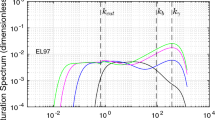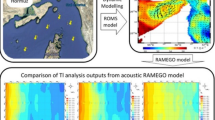Abstract
Numerical models used in coastal engineering must be computationally efficient while maintaining accuracy at an engineering level. One major weakness of models based on non-hydrostatic Reynolds Averaged Navier–Stokes (RANS) equations is the solution of the Poisson equation used to evolve pressure values over time, accounting for up to 70% of the computational time. We propose a method that uses a differential grid to reduce the computational costs while maintaining a good accuracy: a “subgrid approach”, in which pressure values are computed on a coarse grid while velocities are solved on a finer grid. In addition, the grid resolution is increased near the surface and bottom boundaries. This approach is applied to Iravani et al. (Coast Eng 159:103717, 2020. https://doi.org/10.1016/j.coastaleng.2020.103717) model, which also implements novel free surface boundary conditions for breaking waves. The results show how the computational effort can be reduced up to 70% while providing more than satisfactory results for properties of interest for the coastal engineering practice, like wave height decay and mean water elevation.















Similar content being viewed by others
Data availability
The datasets generated during and analyzed during the current study are available from the corresponding author on reasonable request.
References
Iravani, N., Badiei, P., Brocchini, M.: Novel free surface boundary conditions for spilling breaking waves. Coast. Eng. 159, 103717 (2020). https://doi.org/10.1016/j.coastaleng.2020.103717
Ma, G., Shi, F., Kirby, J.T.: Shock-capturing non-hydrostatic model for fully dispersive surface wave processes. Ocean Model 43–44, 22–35 (2012). https://doi.org/10.1016/j.ocemod.2011.12.002
Shi, J., et al.: Pressure decimation and interpolation (PDI) method for a baroclinic non-hydrostatic model. Ocean Model 96, 265–279 (2015). https://doi.org/10.1016/j.ocemod.2015.09.010
Van Reeuwijk, M.: Efficient simulation of non-hydrostatic free-surface flow (Wave simulation with interpolation of the vertical pressure profile) Thesis May 2002, Delft University of Technology, Faculty of Civil Engineering and Geosciences, Section Fluid Mechanics Regards.
Rijnsdorp, D.P., Smit, P.B., Zijlema, M., Reniers, A.J.H.M.: Efficient non-hydrostatic modelling of 3D wave-induced currents using a subgrid approach. Ocean Model 116, 118–133 (2017). https://doi.org/10.1016/j.ocemod.2017.06.012
Rijnsdorp, D.P., Smit, P.B., Zijlema, M.: Non-hydrostatic modelling of infragravity waves under laboratory conditions. Coast. Eng. 85, 30–42 (2014). https://doi.org/10.1016/j.coastaleng.2013.11.011
Brocchini, M.: Free surface boundary conditions at a bubbly/weakly splashing air–water interface. Phys. Fluids 14(6), 1834–1840 (2002). https://doi.org/10.1063/1.1475998
Ting, F.C.K.K., Kirby, J.T.: Observation of undertow and turbulence in a laboratory surf zone. Coast. Eng. 24(1–2), 51–80 (1994). https://doi.org/10.1016/0378-3839(94)90026-4
Author information
Authors and Affiliations
Corresponding author
Ethics declarations
Conflict of interest
On behalf of all authors, the corresponding author states that there is no conflict of interest.
Additional information
Publisher's Note
Springer Nature remains neutral with regard to jurisdictional claims in published maps and institutional affiliations.
Appendix
Appendix
The following figures show the comparison between numerical results and experimental data of Ting and Kirby [8] for the TKE and velocity profiles. As indicated in the captions, different grid configurations and numerical methods are used Figs. 16, 17, 18, 19, 20, 21, 22.
Comparison between the numerical results and the experimental data of the Spilling breaker case of Ting & Kirby for the time-averaged velocities and time-averaged TKE. a Solving the momentum equation on the fine grid (blue dotted line), b solving the vertical momentum equation on the coarse grid (continuous red line)
Rights and permissions
About this article
Cite this article
Iravani, N., Badiei, P. & Brocchini, M. Improving the Performances of a Novel RANS Model for Breaking Water Waves Using a Subgrid Approach and Non-equidistant Layers. Water Waves 4, 447–490 (2022). https://doi.org/10.1007/s42286-022-00066-4
Received:
Accepted:
Published:
Issue Date:
DOI: https://doi.org/10.1007/s42286-022-00066-4

























